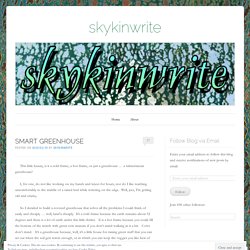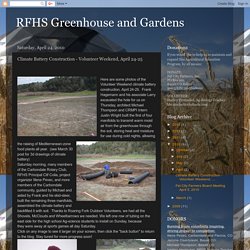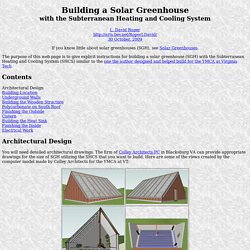

Into new territory. After meeting a good friend for lunch today and telling her all about my latest and greatest events in my life she has insisted that I start a blog and log my journey with everyone else on the planet as a witness.

What she seems so interested in was our new greenhouse and growing system that we put in. What I have come up with was a combination of a Walipini (underground greenhouse) and an Aquaponic system. The walipini was a no brainier for us as we live out on the prairie. Wind and hail are a norm for us. All the normal greenhouses that you can buy from box stores and such are just no match for what mother nature has in store for us out here. Our Walipini has an inner dimention of 20'x36' and is 6' deep. Sunken Greenhouse (1) SMART GREENHOUSE. This little beauty, is it a cold-frame, a hot-frame, or just a greenhouse … a subterranean greenhouse?

I, for one, do not like working on my hands and knees for hours, nor do I like reaching uncomfortably to the middle of a raised bed while tottering on the edge. Well, jeez, I’m getting old and cranky. So I decided to build a covered greenhouse that solves all the problems I could think of easily and cheaply … well, kind’a cheaply. It’s a cold frame because the earth remains about 52 degrees and there is a lot of earth under this little shelter. It is a hot frame because you could fill the bottom of the trench with green cow manure if you don’t mind walking in it a bit. It’s subterranean — largely. That’s the barebones gist of it.
Should I point out that this is a simplified drawing? No kneeling or uncomfortable bending over or balancing precariously upon a wooden or stone wall. That’s the basic package. To be honest, I haven’t built this yet. You are wise. Like this: Like Loading... Grow Food Year Round in a $300 Underground Greenhouse » Homestead Guru. The word Walipini, derived from the Aymaran language and an indigenous Bolivian tribe, is translated as “a place of warmth” and is an earth sheltered cold frame or transparent-roofed enclosure.

This underground greenhouse was created for the cold regions of South America to maintain food production year round, but is now being adopted by gardeners of all skill levels across the world. Most say that Walipinis should be at least 8’ by 12’ in size, but many people build even larger. Searching online you can find all types of plans and blueprints on how to design your underground greenhouse. The temperature six to eight feet below the surface fluctuates from 50 up to 70 degrees Fahrenheit! If you are in an especially cold climate you would want to lay the inside of your walipini with stone, earth bags of lava rocks, or any dense material able to store heat. Minimal up keep: Seeing as the walipini is sheltered by the earth the materials will not wear as quickly. Grow Food Year Round in a $300 Underground Greenhouse » Homestead Guru. Climate Battery Construction - Volunteer Weekend, April 24-25.
Here are some photos of the Volunteer Weekend climate battery construction, April 24-25.

Frank Hagemann and his associate Larry excavated the hole for us on Thursday, architect Michael Thompson and CRMPI Intern Justin Wright built the first of four manifolds to transmit warm moist air from the greenhouse through the soil, storing heat and moisture for use during cold nights, allowing the raising of Mediterranean-zone food plants all year. (see March 30 post for 3d drawings of climate battery) Saturday morning, many members of the Carbondale Rotary Club, RFHS Principal Clif Colia, project organizer Illene Pevec, and more members of the Carbondale community, guided by Michael and aided by Frank and his skid-steer, built the remaining three manifolds, assembled the climate battery and backfilled it with soil.
Thanks to Roaring Fork Outdoor Volunteers, we had all the Shovels, McClouds and Wheelbarrows we needed. Building a Solar Greenhouse with the Subterranean Heating and Cooling System. L.

David Roper 30 October, 2009 If you know little about solar greenhouses (SGH), see Solar Greenhouses. The purpose of this web page is to give explicit instructions for building a solar greenhouse (SGH) with the Subterranean Heating and Cooling System (SHCS) similar to the one the author designed and helped build for the YMCA at Virginia Tech. Contents. Pinterest. Building a Solar Greenhouse with the Subterranean Heating and Cooling System. Pit Greenhouses - Solar Innovations ®Solar Innovations ® Home » Our Products » Aluminum Structures » Greenhouses » Pit Greenhouses Pit greenhouses are extremely energy efficient, as they are essentially a hole dug into the ground with an attached glass structure.

At a depth of four feet, the Earth retains a temperature of roughly 50 degrees year round; almost 10 degrees warmer than that of an above ground greenhouse. If your greenhouse requires a temperature of 70 degrees, the temperature will only need to be raised 20 degrees. A traditional above ground greenhouse can easily drop below freezing during winter months; most plants require constant 60 degree temperatures. Stabilizing the temperature by using a pit greenhouse will reduce energy costs and allow you to nurture plants year round.
Plant Selection The plants you choose to cultivate will need to be taken into account when determining which heating method will be used in the greenhouse. Plants are often grown directly in the soil in pit greenhouses. Heating & Cooling Configurations.